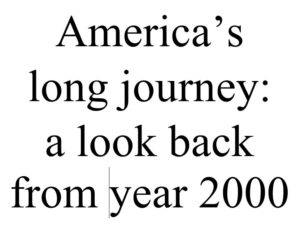
The Election of 1828
In viewing political movement, we tend to mistake cause for effect. Thermometers don’t cause fevers, they reflect them. Elections usually don’t determine political realignments; they reflect realignments that have already taken place. The 1828 fever-chart showed a nation in the midst of several profound transitions.
Before 1828, politics was still more or less in the hands of the class that had shaped the revolution and had guided the republic through its first half century. For all the bitter differences between New England federalists and the Virginia dynasty, they were all statesmen shaped by the confrontation with England; they were all classically educated; they were all aristocrats or their lawyers.
Before 1828, presidential nominations came by way of congressional caucus. The assumption was that elected officials were the best judges of which candidates were best qualified to become chief magistrate. Various geographical regions had their own candidates, and political insiders judged among them. The people in general acquiesced, leaving politics to their betters.
Jackson’s election shook up the whole system. Partly it was his doing; partly it was Jackson being elevated by the rising tide.
As soon as Adams was inaugurated as president in 1825, Jackson resigned from his senate seat and set out with characteristic single-mindedness to replace him. Working with brilliant New York politician Martin Van Buren, he assembled a coalition that reshaped American politics. His charismatic personality and controversial policies energized a large part of the American electorate that until then had been content to leave the decision to the professionals and to the upper and middle classes who had heretofore dominated political life. Now, the common people were emotionally engaged to an unprecedented degree.
With this new engagement came partisan press attacks even more bitter than those that had harassed Washington and his successors to date. With it came a new degree of personal party loyalty. Politics assumed an importance in voters’ lives that it never had before. Within a few years, selection of presidential candidates by Congressional caucus had to be replaced by selection by political conventions.
Jackson’s single-minded campaign to replace Adams succeeded. He swept every region of the country except New England, New Jersey and Delaware, winning 178 electoral votes to Adams’ 83. The full results of Jackson and Van Buren’s alliance took a while to become obvious, but in retrospect it could be seen that it had carried the republic’s politics from its 1824 state of flux into what historians call the Second Party System of Democrats and Whigs.
The Democracy held to low tariffs (for revenue purposes only, rather than protection), to silver and gold, and to the older pattern of small family farms, and expansion to provide more land to continue the old pattern. As might be imagined, the Democracy’s strength centered on the frontier and in more isolated areas.
But Jackson’s and Van Buren’s party brought forth an opposition party, which called itself the Whig Party (in opposition to “King Andrew”) led by Henry Clay. The Whigs had a program for modernizing the economy – Clay’s American System – and their numbers included bankers, businessmen, and commercial farmers. Whigs flourished in the cities and, outside the cities, in market towns and commercial areas. They argued for high tariffs to foster the growth of American industry, for banks and paper money to facilitate commerce, and for public works programs to build roads, canals and railroads, to provide the infrastructure needed for rapid economic development.
(Minor parties sprang up and went away – the Anti-Masonic Party, the Liberty Party, later the Free Soil Party – but the pattern was fixed as Democrats versus Whigs until the Whigs split up and the Republican Party was born in the 1850s.)
This Second Party System endured for a quarter century, until the mounting uproar over the expansion of slavery destroyed the Whigs and brought forth the Republicans. Most Whig policies became Republican policies, just as many prominent Republicans, such as William Seward and Abraham Lincoln, were former Whigs. The changing times favored their vision of the nation’s future.
The Democracy had a brief period of dominance, peaking in the presidency of James Polk, but in retrospect it can be seen that they were trying to hold back the tide. We were not going to be a nation of small towns and small farms. The Democracy went into a decline that lasted, with brief and almost accidental interruptions (the presidencies of Cleveland and Wilson) until the Great Depression reshaped politics once again. The Democrats had hitched their wagon to the wrong star.